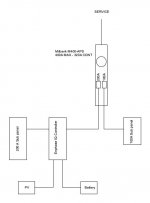whackit
Member
- Location
- Los Angeles, CA
Hi Folks,
Always appreciate the help here when I'm stumped. I have a weird situation that I'm not sure how to make sense of. Homeowner looking to add a large PV setup with battery backup. Service enters house in a Milbank meter main that has only 2 breakers spots that are filled with 1x100amp breaker and 1x200amp breaker that feed two downstream sub panels. The 200A panel is for the main house and the 100A panel is for a garage/guest house. We want to install a Enphase system controller in between the main panel and the 200A sub to backup main house. The main 200A breaker in the service meter would cover both the solar and the sub panel (there is also a 200amp breaker on sub and they can be fit on both sides of the Enphase control if necessary). See attached image for clarity, apologies for iPad drawings from truck.
So how does the 120% rule apply here (or does it not?). Are the two breakers in the service panel considered "opposite ends" of it's buss even though they are right next to each other? Doesn't the 200A breaker in the main panel which is handling both the solar and the grid loads protect the buss as it is handling the full current?
Not sure why this is stumping me (and a few others). Any insight appreciated.

Always appreciate the help here when I'm stumped. I have a weird situation that I'm not sure how to make sense of. Homeowner looking to add a large PV setup with battery backup. Service enters house in a Milbank meter main that has only 2 breakers spots that are filled with 1x100amp breaker and 1x200amp breaker that feed two downstream sub panels. The 200A panel is for the main house and the 100A panel is for a garage/guest house. We want to install a Enphase system controller in between the main panel and the 200A sub to backup main house. The main 200A breaker in the service meter would cover both the solar and the sub panel (there is also a 200amp breaker on sub and they can be fit on both sides of the Enphase control if necessary). See attached image for clarity, apologies for iPad drawings from truck.
So how does the 120% rule apply here (or does it not?). Are the two breakers in the service panel considered "opposite ends" of it's buss even though they are right next to each other? Doesn't the 200A breaker in the main panel which is handling both the solar and the grid loads protect the buss as it is handling the full current?
Not sure why this is stumping me (and a few others). Any insight appreciated.


